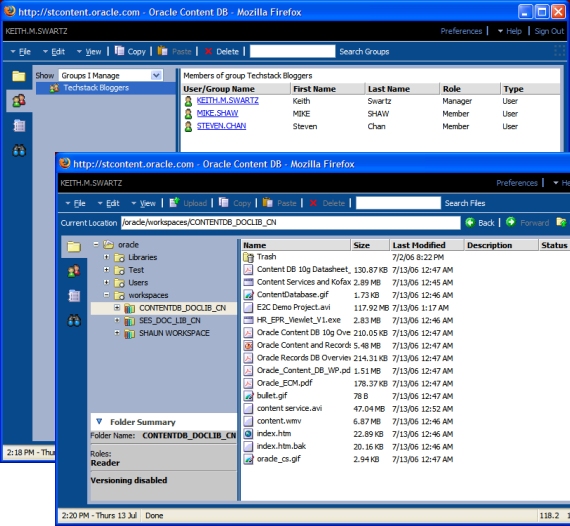[Editor Update May 21, 2008: Keith has moved on to another team within Oracle and, sadly, is no longer an active contributor to this blog. Feel free to direct any questions about his posted articles directly to Steven Chan, instead.]
Oracle has been making big strides in the area of content management. A recent press release touted two new products, Oracle Content Database and Oracle Records Database (or just Content DB and Records DB, for short). In short, Content DB allows you to use a single Oracle database instance as a repository for all kinds of unstructured data, and gives you the ability to use powerful tools like SQL and database privileges to query and manage that data. Records DB offers additional lifecycle management utilities that allow you to apply policies for document auditing, retention, and disposal to meet regulatory compliance obligations.
A Brief History of Content Management at Oracle
If this sounds familiar to you, then you’re one of the not-so-many people who’s been paying attention to this space over the past few years. Oracle’s content management offerings are not entirely new, having undergone several transformations, from iFS, to Oracle Files, to the more recent Oracle Content Services, introduced in Oracle Collaboration Suite 10g. Starting later this summer, this latter incarnation will be rechristened as Oracle Content Database, and will henceforth be available as an option for the Enterprise Edition of Oracle Database 10g.

This marks the first time that a content management product has moved out of being in its own collaboration offering, and into the head-of-the-class database suite. It makes a strong statement about the importance of having access to the right tools for managing the overwhelming amounts of data companies are juggling today. Hopefully making it easier to obtain and install that technology will be a big step toward easing the burden. (Note that shortly after Oracle made this announcement, Microsoft announced that their perpetually elusive WinFS project was being taken out of the operating system track, and integrated into their SQL Server product. Coincidence? One has to wonder.)
I Want It Now!
Today, there are a handful of E-Business Suite products that offer optional integration with Oracle Files and/or Oracle Content Services, including Product Lifecycle Management, Internal Controls Manager, and Oracle Tutor.
For instance, Oracle Document Management is an integral component of PLM that allows product designers & engineers to associate large numbers of files and documents that have their own lifecycle policies. It supports features such as check-in/check-out, major/minor revisions & versions, access control, associations (to E-Business Suite objects), and more…all on top of Oracle Content Services. Going forward, we expect that many more products will be enticed to provide support for both Oracle Content DB and Oracle Records DB.
Now in the Bullpen
To aid in this process, the folks here at Techstack Central are looking at how we can make it easier for E-Business Suite teams to offer such support in their products. Content DB and Records DB will be available starting in August, and our evaluation of these products for integration with Release 12 is already well underway.
Our Mail Filters Are Standing By
We will be making a decision at a later time regarding support with Release 11i, but in the meantime, if this combination is deemed critical for your company (and an upgrade to Release 12 is not in the cards), you can always help us out by letting us know about it, either by adding a comment to this blog entry, or by sending me or Steven an email.
Be sure to tell us which specific products you are interested in integrating with our content management solutions.